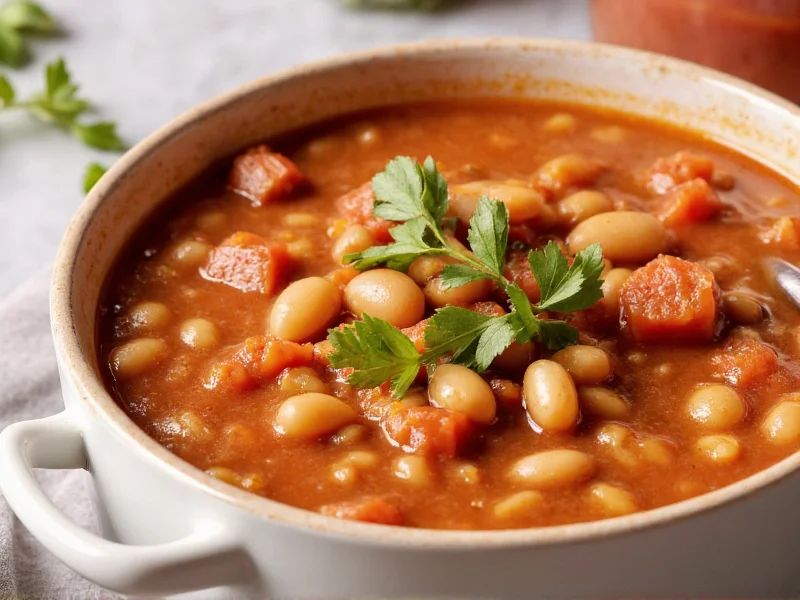Transforming canned bean soup from ordinary to exceptional requires understanding its composition and limitations. While convenient, standard canned versions often contain excessive sodium (600-900mg per serving) and lack depth of flavor compared to homemade. The good news: with strategic enhancements, you can create restaurant-quality meals in under 15 minutes using this pantry staple.
Nutritional Profile and Health Considerations
Bean-based soups deliver significant nutritional benefits when properly prepared. A standard 14.5-ounce can typically provides:
| Nutrient | Per Serving (1 cup) | Daily Value % |
|---|---|---|
| Calories | 180-220 | 9-11% |
| Protein | 8-10g | 16-20% |
| Fiber | 5-7g | 20-25% |
| Sodium | 600-900mg | 26-39% |
| Iron | 15-20% | 15-20% |
To reduce sodium without sacrificing flavor, rinse beans thoroughly before use or select low-sodium varieties. Adding potassium-rich ingredients like tomatoes or spinach helps balance electrolytes. For enhanced protein content, stir in cooked chicken, turkey, or additional beans during reheating.
Five Professional Techniques to Elevate Canned Bean Soup
Professional chefs use these methods to transform basic canned soup into gourmet dishes:
- The Acid Test: Finish with 1-2 teaspoons of vinegar (sherry vinegar for white beans, apple cider for darker varieties) or fresh lemon juice to brighten flavors
- Aromatic Foundation: Sauté onions, garlic, and celery in olive oil before adding soup to build flavor complexity
- Umami Boosters: Stir in 1 teaspoon soy sauce, miso paste, or tomato paste for deeper savory notes
- Texture Contrast: Top with toasted seeds, croutons, or a drizzle of quality olive oil before serving
- Herb Infusion: Simmer with fresh rosemary or thyme sprigs for 10 minutes, then remove before serving
Comparing Popular Canned Bean Soup Varieties
Not all bean soups perform equally in recipes. This comparison helps select the best option for specific applications:
| Variety | Best For | Flavor Profile | Special Handling |
|---|---|---|---|
| Cannellini Bean | Creamy soups, pasta dishes | Mild, slightly nutty | Add lemon juice to prevent darkening |
| Black Bean | Mexican-inspired dishes, chili | Earthy, robust | Boost with cumin and lime |
| Minestrone | Hearty meals, Italian cuisine | Vegetable-forward | Add Parmesan rind while simmering |
| Great Northern | French-inspired dishes | Creamy, delicate | Pair with white wine and herbs |
Creative Recipe Applications Beyond the Bowl
Expand your culinary repertoire with these innovative uses for canned bean soup:
- Soup-Based Casseroles: Combine with cooked pasta, cheese, and vegetables for a quick bake
- Sauce Thickener: Use pureed white bean soup as a creamy base for pasta sauces
- Marinade Component: Blend with spices for tenderizing meats before grilling
- Dip Foundation: Mix with cream cheese and roasted garlic for instant party dip
- Grain Bowl Base: Heat and pour over quinoa or brown rice with roasted vegetables
Storage Guidelines and Shelf Life
Proper storage maximizes both safety and quality:
- Unopened cans: Store in cool, dry place for 2-5 years (check for dents or bulges)
- Opened soup: Transfer to airtight container and refrigerate for 3-4 days
- Freezing: Portion into ice cube trays, then transfer to freezer bags for up to 3 months
- Reheating: Warm gently over medium-low heat to prevent separation
Discard any soup showing signs of spoilage: sour smell, mold growth, or unusual texture changes. When in doubt, follow the food safety principle: "When you doubt, throw it out."
Addressing Common Flavor Challenges
Many home cooks encounter these issues when using canned bean soup:
- Flat flavor: Add 1/4 teaspoon smoked paprika or a strip of kombu seaweed while heating
- Excessive saltiness: Stir in diced potatoes to absorb excess sodium during reheating
- Watery consistency: Simmer uncovered for 5-7 minutes to reduce liquid
- Lack of depth: Brown a tablespoon of tomato paste before adding soup
Frequently Asked Questions
Can I use water instead of milk with condensed bean soup?
Yes, water works as a thinner for condensed bean soup, though it produces a less creamy result than milk. For optimal texture, use a 50/50 mix of water and milk, or substitute unsweetened plant-based milk for dairy-free creaminess.
How do I prevent canned bean soup from separating when reheating?
To prevent separation, heat soup gently over medium-low temperature while stirring frequently. Avoid boiling. If separation occurs, whisk vigorously while adding 1-2 teaspoons of cold water. Adding a small amount of cornstarch slurry (1 teaspoon cornstarch mixed with 1 tablespoon cold water) can also stabilize the emulsion.
What's the best way to add vegetables to canned bean soup?
For optimal texture and flavor, sauté vegetables like carrots, celery, and onions before adding the soup. Delicate greens like spinach should be stirred in during the last 2 minutes of cooking. Frozen vegetables work well added directly to simmering soup and cooked until tender (5-7 minutes).
Can I make canned bean soup vegetarian-friendly if it contains meat broth?
Yes, most meat-based bean soups can be made vegetarian by draining the soup, rinsing the beans, and adding vegetable broth. For best results, use twice the amount of vegetable broth as the original liquid content, and enhance with umami boosters like soy sauce or nutritional yeast to compensate for lost meat flavors.
How can I make canned bean soup heartier for a main course?
Transform canned bean soup into a satisfying main course by adding 1 cup cooked grains (quinoa, rice, or farro), 1/2 cup diced cooked chicken or tofu, and extra vegetables. Simmer for 5-7 minutes to blend flavors. Top with fresh herbs and a sprinkle of cheese for restaurant-quality presentation.











 浙公网安备
33010002000092号
浙公网安备
33010002000092号 浙B2-20120091-4
浙B2-20120091-4